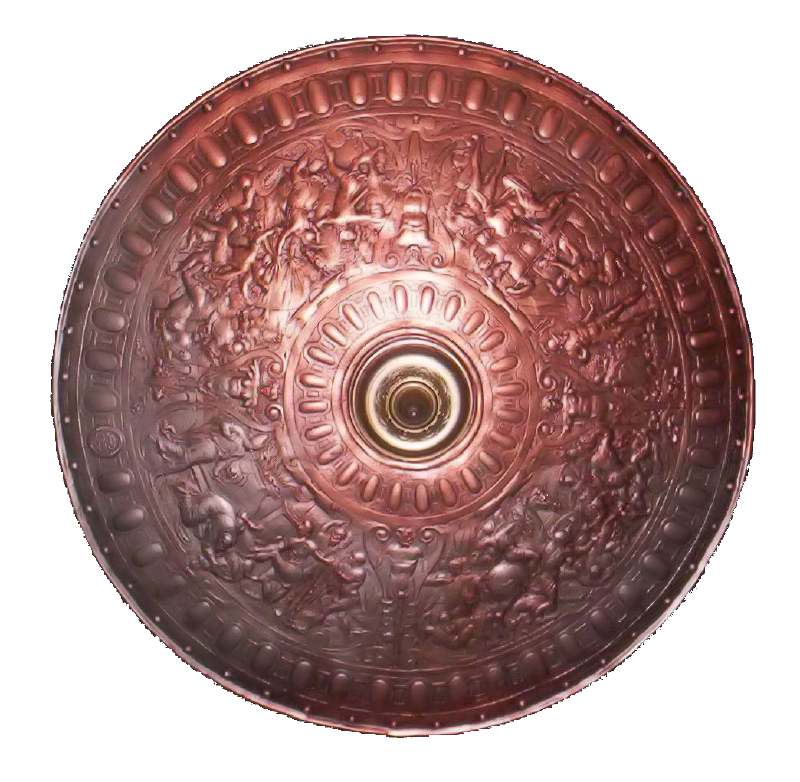Throughout history and across cultures there have been many different kinds of armor. The armor types presented in the rules are a vast simplification. They provide an interesting choice of protective clothing without too much confusion. Within any game world, however, Adventure Guides may make more types of armor available, varying bulk, effectiveness, and maintenance costs.
Shields and Helmets

Like other kinds of armor, shields and helmets come in a bewildering number of styles. For game purposes, shields are divided into normal, small, and large. The normal shield is the one that will be used most often. It isn’t too bulky, but provides good protection against multiple foes.
Small Shield
The small shield, such as some of the smaller bucklers, requires more skill than other shields because it is so small. It can only be used against a single opponent at a time. It is often used in ceremonial combat or single combat, where the warrior knows that they will only be facing a single opponent.
Because they are most often used in ceremonial combat, small shields are often more heavily stylized and decorated than other shields.
Large Shield
The large shield is around four feet tall, semi-cylindrical, and about two feet wide. It weighs upward of 20 pounds but provides the skilled warrior with significant protection. The large shield is large enough that multiple warriors can form a shield wall for strong cover.
Full Helmet
The full helmet is usually metal, and covers the entire head. It provides significant protection but at the expense of a constricted visual range and a commensurate loss of hearing.
Basic Armor
Most armor is in the form of shirts, leggings, and long sleeves all of similar material. Leather armor usually includes simple leather headgear, and chain mail usually includes chain mail headgear.
Basic Armor: Cloth
Cloth armor consists of padded and hardened cloth. While not particularly protective, it was better than nothing, was inexpensive, and did not significantly inhibit other types of movement.
Basic Armor: Leather
Leather armor is made from leathered hides: tanned and hardened animal skins. Very effective, not particularly bulky, leather armor is the most common armor used by non-warriors.
Banded Leather
“Banded” leather armor is a softer leather interwoven with metal (usually iron) plates in bands across the front and over the shoulder and laced at the back. Banded leather is probably the most common armor worn by veterans in mobile armies, as it provides a solid balance between expense, maintenance costs, maneuverability, comfort, and protective capability. This was the typical armor used by the Roman legions. It weighs about twenty pounds. Roman armor of this type is called “lorica segmentata”.
Basic Armor: Chain Mail
Chain mail is perhaps the most highly advanced of all armor types, and one of the more expensive. It is difficult and time-consuming to manufacture, but it is very protective and the most easily maneuvered of the true metal armors. Use of chain mail is generally limited to the upper classes and those with the economic resources to commission it and maintain it.
Warrior Armor
Warrior Armor: Scale
Scale mail consists of either metal scales or rings sewn onto a hardened cloth or leather backing, often overlapping each other much like scales. It is less expensive than chain mail but also less maneuverable. Some more decorative scale armor used scales embossed with symbols, and some even used coins. Scale mail is extremely impressive when polished, but requires more maintenance lest the wearer end up like Tolkien’s dragon. It can also be extremely hot. To the Romans, the wearer of such armor was nicknamed “clibanarius,” or “oven man”. Scale mail weighs around 60 pounds.
Scale armor is a very early form of armor and is likely to be present in any warring culture that has both tanning and metalworking skills.
Warrior Armor: Splint
Splint armor is an early form of plate mail. Metal plates were riveted together, or to a backing of cloth and leather. Similar to banded leather splint armor provided more complete protection but was usually abandoned when plate mail became available.
Warrior Armor: Plate
Plate armor is an advanced form of armor that is not always available. While more maneuverable than it looks, plate armor is still heavy, hot, and difficult to move in. More than the technical skill required to make it, plate armor is unlikely to be used unless there are advanced weapons or weapon techniques that need to be defended against in such a fashion. Plate armor is less likely to be available before the invention of the stirrup, as it was the stirrup that allowed for heavier lances to be used on horseback.
Plate mail comes in three basic types: normal plate mail, full plate, and ceremonial plate. Normal plate is a combination of chain mail with plates protecting important locations such as the chest, shoulders, outer arms, hamstrings, and knees. Places that need maneuverability, such as hands, midriff, and neck, were often protected only by chain mail. Normal plate armor is sometimes called transitional plate.
Full plate requires higher quality construction. It is designed for full coverage and for maneuverability in chaotic combat conditions. Because of the greater care in its design, full plate can plate parts of the body that would normally have only been covered in chain mail.
Ceremonial plate is reserved for ceremonial combat, as it was expensive to create and maintain and limited the ability of the wearer to respond to chaotic combat conditions. Ceremonial plate is specialized for the particular concerns of ceremonial combat, such as jousting.
Plate armor is well suited to decoration, with plates being painted and embossed, and with extra metal parts added to provide a good show or an intimidating appearance.
